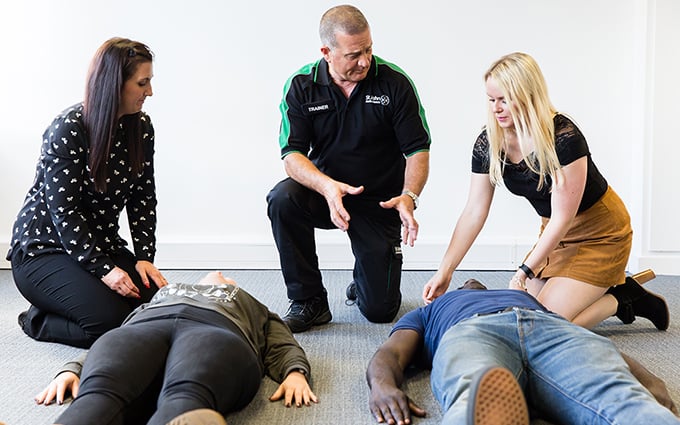Written on 24th February 2022
Working with Hope & Glory, using the help of One Poll, we conducted research with a sample group of 2000 employed adults who did not work from home before the pandemic. We wanted to understand the impact that working from home and hybrid working might have on first aid in the workplace as work-life as we know it changes.
Changes to the average working week
When we think about the average working week, most people picture 9am – 5pm Monday through Friday. However, spurred on by COVID-19, ‘the average working week’ might become obsolete. Forced to work from home due to the pandemic, many employees have now seen a change in the way their organisation operates, perhaps because they have proven that working from home can be just as effective. Hybrid working is a type of flexible working where an employee splits their time between the workplace and remote working.
Almost half (48%) of UK employed adults who don’t normally work from home say their employer has introduced flexible working arrangements on a permanent basis since the pandemic. This includes:
- One fifth (20%) who are now completely flexible (i.e. can always choose where they work)
- More than a quarter (29%) are now somewhat flexible (i.e. have days each week where they can choose where they work and others where they must work from their usual workplace)
- While three in ten (30%) say their employer has not introduced any kind of flexible working, just 3% were already fully flexible prior to the pandemic.
From those surveyed whose role does/would accommodate flexible working:
- 46% would prefer to work on a completely flexible basis
- Just over a third (34%) would like to be partially flexible
- And 14% would prefer to be not flexible at all
Why do we need Workplace First Aiders?
In the event of injury or sudden illness, failure to provide first aid could result in a casualty's death. It is an employer’s responsibility to ensure that there are adequate and appropriate equipment, facilities, and personnel available to assist a casualty. It’s vital to remember that there should always be trained personnel on-site, so work rotas and remote working needs to be considered.
More than half (55%) of those we surveyed know how many first aiders there are at their place of work, whilst 39% don’t know how many first aiders are at their workplace. As high as 6% of those we surveyed, admitted that there aren’t any first aiders on their premises; The Health and Safety Executive (HSE), Britain's national regulator for workplace health and safety, will prosecute in cases where there is a significant risk, a disregard for established standards or persistent poor compliance with the law.
One in ten (10%) say there are more first aiders at their place of work since the start of the pandemic, perhaps encouraged by the need for more first aiders in the workplace as some will now work remotely. Nearly half (49%) say the number of first aiders has not changed, but 7% report that there are now fewer first aiders.
Of those who have first aiders at work, 49% say there was a trained first aider at their place of work when they visited during the last fortnight, while 9% admit no first aider was present.
Emergencies in the workplace
Emergencies in the workplace are more common than you think and can happen anywhere, at any time. Two fifths (40%) of the people we surveyed have witnessed a first aid emergency at work, with 20% of those having seen an emergency multiple times. Just over a fifth (21%) have personally required first aid attention at work, with 7% having needed first aid multiple times
Incredibly, 17% are aware of someone’s life being saved at their workplace.
Incredibly, 17% are aware of someone’s life being saved at their workplace. Of those who have witnessed a first aid emergency at work, 25% witnessed someone suffering a cardiac arrest.
The most common first aid emergency at work was due to a cut/bleed, witnessed by just over half of our group (51%). Other common workplace injuries included someone falling over (45%) and someone fainting (45%).
37% of this group admitted that they would not know what to do if they witnessed a first aid emergency at work and had to administer first aid., which highlights the need for trained first aiders to be at your workplace at all times.
Where does first aid belong in a hybrid world?
The need for first aiders in the workplace has not disappeared along with the roll out of remote and hybrid working. Accidents in the workplace are still as likely as ever, and it’s important that your workplace is equipped and ready to support a casualty at any time. Nearly three quarters (73%) of the people we surveyed think first aid is very important.
The previous 2 years have brought several challenges including increased hybrid working, redundancies and employees leaving employment due to personal circumstances; some of these people no longer in the workplace may have been your first aiders. It is imperative that you keep on top of your workplace safety and ensure you have enough first aid trained individuals on-site at any one time. With more people choosing to work remotely, this may mean that you need to have more trained first aiders amongst your workforce to always ensure coverage.
You can use our free online calculator to help indicate how many first aiders your workplace may need.
Develop your first aid skills
Your workplace requires trained first aiders. If you'd like to develop your first aid skills, our 1-Day Emergency First Aid at Work and 3-Day First Aid at Work courses have you covered.
With more people preferring to choose a hybrid style of working, why not consider our new Blended First Aid at Work Requalification course which takes the same approach? This course combines online and face-to-face learning to update the first aid skills of those who need to renew their First Aid at Work certificate, giving delegates a more flexible approach to traditional training.
We’re trying to cater to the new hybrid working market with our first aid training offering and we will soon be launching our brand new Blended First Aid at Work courses, following the success of the aforementioned requalification courses. This means that you are now able to undertake the first part of our course online and shortening the time you need to spend in face-to-face training.



